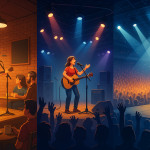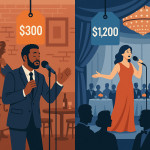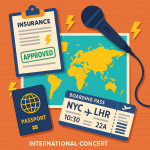How to pitch yourself to festival bookers before singer event deadlines
Festival slots disappear fast. This guide shows you how to research deadlines, craft a memorable pitch, and reach festival bookers early enough to land prime performance spots. Follow the timeline, tools and email tactics below to move from inbox unknown to confirmed act.
1. Decode festival timelines before you write a single line
Check standard lead times
Most mid-to-large music festivals lock headliners 9-12 months out and confirm emerging acts 5-7 months before show day. Smaller community events decide closer to 3 months. Knowing these windows stops you wasting time on line-ups that are already full.
| Festival type | Average application window | Typical decision date |
|---|---|---|
| International marquee festivals (e.g., Glastonbury) | 12 – 9 months | 8 months prior |
| Regional multi-stage festivals | 8 – 6 months | 5 months prior |
| City showcase weeks (SXSW-style) | 7 – 5 months | 4 months prior |
| Local cultural fairs | 4 – 3 months | 2 months prior |
| Pop-up or charity events | 3 – 1 months | 3-4 weeks prior |
Gather specific dates fast
- Bookmark the event singer directory on Artfolio and filter by “submissions open”.
- Set Google Alerts for “artist submissions + festival name”.
- Scrape last year's FAQ pages; deadlines rarely shift by more than two weeks.
2. Build a pitch kit that turns curiosity into confirmation
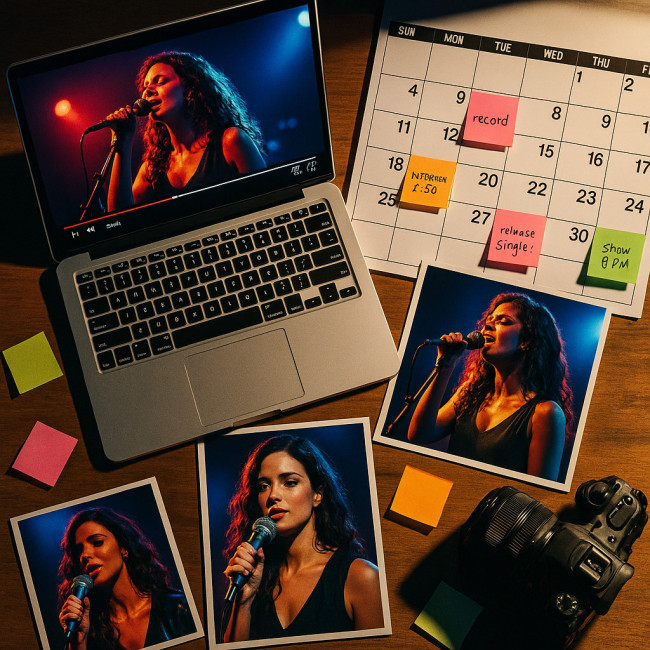
Look closely at the scene above: every object in it reinforces a piece of the advice you are about to apply. The open laptop shows a paused 30-second sizzle reel, ring-light reflections highlight updated press photos spread across the desk, while colour-coded sticky notes map availability windows around a giant wall calendar. By visualising these elements together you can immediately spot gaps in your own material—maybe the stage plot is outdated or the bio still lists 2022 stats. Keep this mental screenshot handy as you assemble your pitch kit so no essential component gets left behind.
Core elements festival bookers scan first
- 30-second sizzle reel – Quick-cut highlights of live crowd energy and tight vocals.
- One-sheet PDF – Short bio, genre tags, social reach, prior festival credits, tech rider highlights.
- Clear availability calendar – Show buffer days for soundcheck, travel and rain delays.
- Press quotes & streaming stats – Two punchy lines and one global number (e.g., “2.3 M Spotify streams”).
- Contact shortcut – Direct email and WhatsApp; bookers on the road hate forms.
Refresh visual assets before peak outreach. If your photos feel dated, follow the image tips in this directory optimisation guide.
Show you solve programming gaps
Study the festival's past line-ups. If Saturday's bill leans indie-rock, pitch your soul-pop set as a Sunday mood-shifter that keeps crowds on site. Programmers love artists who balance pacing, not duplicate it.
Add proof of reliability
- Screenshot punctual arrival logs from your last tour manager.
- List insurance certificates (public liability, gear cover).
- Display union membership or verification badges.
3. Time your outreach for maximum response
T-minus timeline
Work backwards from the festival date:
- –12 months : Connect on LinkedIn, comment on lineup announcements, warm up the relationship.
- –9 months : Send first value email: “Loved last year's jazz curation; here's a 60-second clip that could bridge soulful and electronic slots.”
- –7 months : Provide availability updates and fresh streaming milestones.
- –5 months : Ask about equipment share or co-promo ideas; this positions you as a partner, not a vendor.
- –3 months : Final follow-up only if you have major news (chart placement, feature singer, award).
If you need a broader roadmap, see this showcase-tour planning article.
4. Craft irresistible subject lines and openers
Festival bookers receive 200+ submissions a week. Your first 50 characters must answer “why you, why now”. Test these frameworks:
- [Festival Name] Sunday afternoon groove – 2M-stream soul duo free 18-20 Aug
- Bridge reggae & EDM on Stage B? Watch 30-sec clip
- Last-mile promo idea: fan bicycle choir parade
Personalise opener lines with on-site observations (stage layout, crowd flow) to prove research effort. Avoid long paragraphs; two sentences + video link converts best.
5. Pick the right outreach channels
| Channel | Best use | Response rate benchmark |
|---|---|---|
| Email (direct) | Detailed pitch kit, attachments | 15 – 22 % |
| LinkedIn DM | Relationship warm-up, quick questions | 30 – 35 % |
| Instagram DM | Visual hook, short video drop | 12 – 18 % |
| Booking platforms | Smaller events filling last slots | 25 – 40 % |
Maintain consistency: if you start on email, reply on email. Mixed channels confuse tracking.
Leverage in-person touches
Attend trade fairs one season ahead. The networking blueprint in this networking article shows how to convert badge scans into post-event calls that slash inbox noise.
6. Negotiate swiftly once interest appears
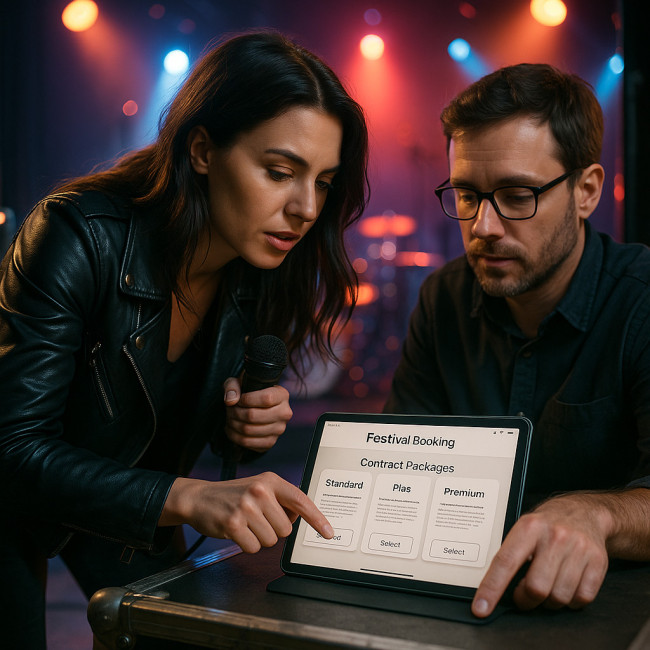
Notice how the image captures a manager and a festival booker leaning over a mixing console rather than a boardroom table. This subtle detail matters: most deal points are hammered out on site between sound-check windows, not during formal meetings. The contract draft on the tablet shows three colour-coded fee packages, travel line items, and a red balloon icon that signals merch percentage. By imagining the negotiation in this context you can rehearse concise answers to likely push-backs—what happens if the workshop overruns or the weather cancels the meet-and-greet? Visual preparation today prevents panic when an offer finally lands in your inbox.
Prepare fee ranges and add-ons
Have three packages ready:
- Performance only – 45-minute set, standard rider.
- Performance + workshop – Adds 60-minute vocal clinic for VIP ticket tiers.
- Full activation – Meet-and-greet, social promo, local press interview.
Bundle travel buyouts and merch percentages ahead of time. Use the rate tips in our performance-fee guide.
Confirm technical needs early
Send a one-page input list and stage plot within 48 hours of verbal interest. This speeds contract moves and signals professionalism.
7. Common mistakes that sink promising pitches
- Missing subject-line date – Bookers forget which weekend you mean.
- Soundcloud only – Provide at least one high-quality live video.
- Ignoring the local angle – Mention city fan metrics; many festivals get regional grants tied to community engagement.
- One email blast to all addresses – Use the correct programmer (folk, electronic, experimental).
- Late replies – Answer within 24 hours; they might slide to the next act.
8. Stay visible between submission and decision
Post rehearsal snippets, tag the festival, and engage with their countdown content. Algorithms reward active mentions, keeping you top-of-mind. Publishing short wins also sharpens your profile metrics, a trick covered in this metrics article.
FAQ
- How early should emerging singers pitch to mid-tier festivals?
- Aim for six to eight months before the festival date. That is when most secondary stages are programmed.
- What file format is best for a one-sheet?
- PDF under 2 MB with live links. Avoid Word or image-only files; many bookers read on mobile.
- Can I pitch a cover-heavy set?
- Yes, if you provide proof of cleared mechanical licences and offer a unique arrangement concept.
Quick knowledge check
Take the next step
Use the checklist above, personalise every message and start pitching today. Each early contact compounds your odds of stepping on that dream stage next season.
Ready to upgrade your full outreach strategy? Bookmark this guide, refine your assets, and schedule your first batch of emails before midnight.

